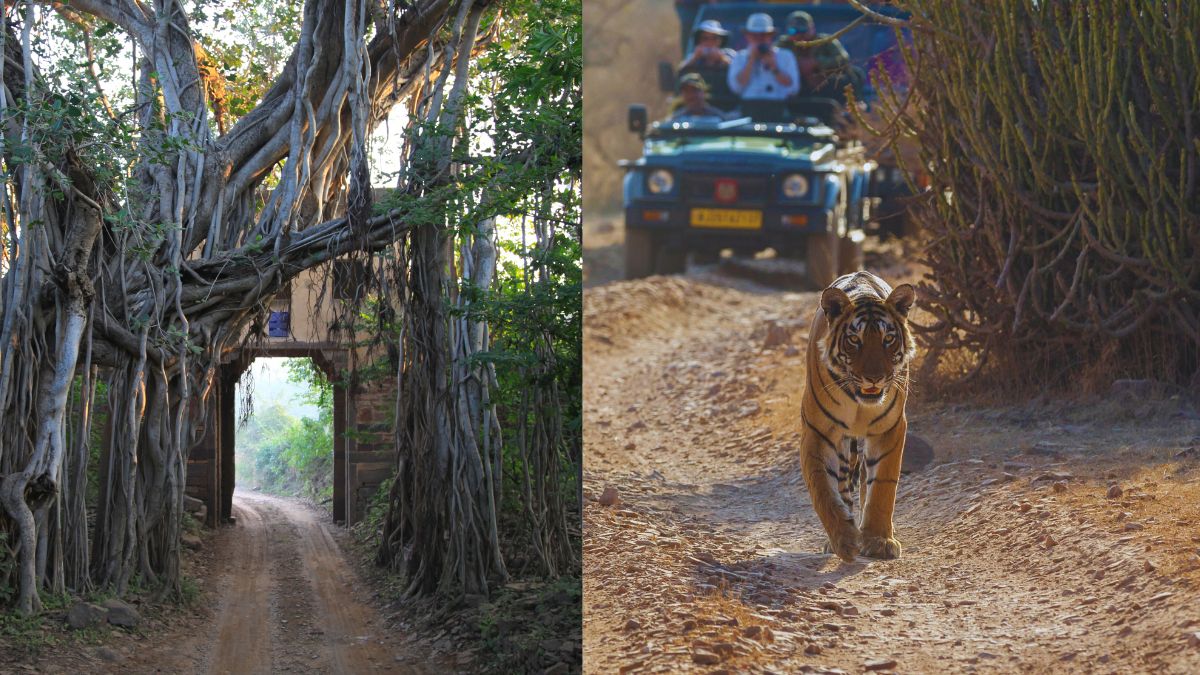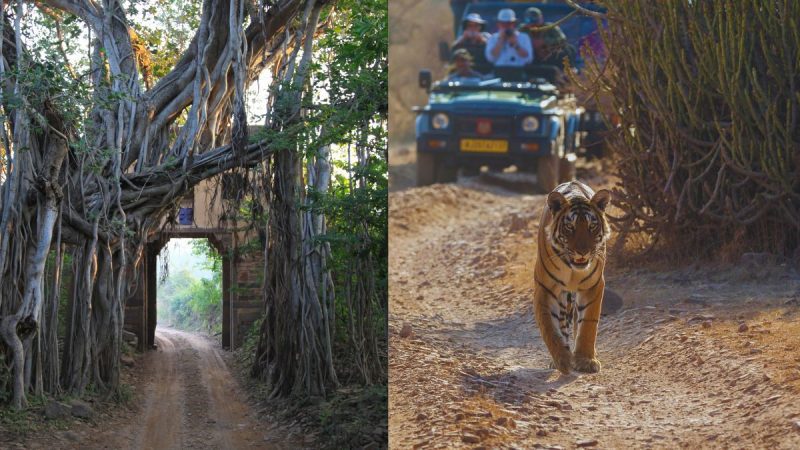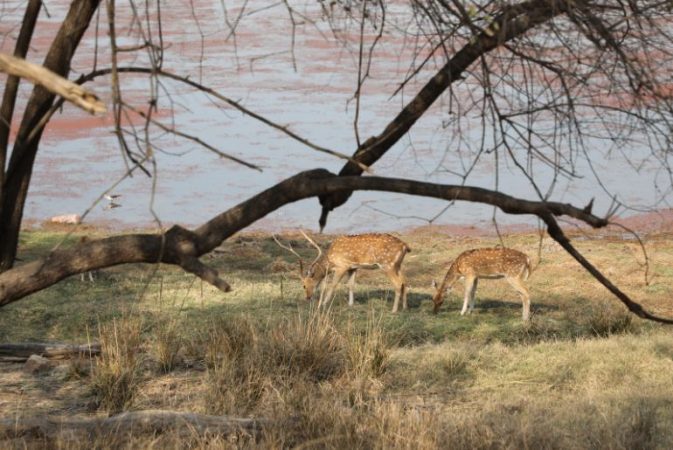It’s late afternoon as I and some of my friends return from the Ranthambore Fort. Suddenly, the safari vehicle comes to a halt. There’s a long line of vehicles blocking the road with people running and shouting, “Aage tiger hai”. The words rippled through the crowd like wildfire, igniting a frenzy of movement and anticipation. With adrenaline coursing through their veins, people jumped out of their vehicles. Guides and tourists alike raced towards the source of the commotion. We had just returned from the highly-regarded Trinetra Ganesha Temple inside Ranthambore Fort. Our prayers must have been answered because the tigress and her cubs lingered on the road for almost an hour. This was the moment I had been waiting for–a chance to witness the untamed beauty of Ranthambore. There she was, Tigress Sultana, lounging regally with her playful cubs!
Safari Life In Ranthambore
View this post on Instagram
Nestled in the rugged terrain of the Aravalli and Vindhya hill ranges, Ranthambore National Park emerges as a crown jewel among India’s vast array of wildlife reserves. The forest’s sprawling expanse of dry deciduous forests, lush meadows, and ancient ruins provides the perfect backdrop for an unforgettable safari experience. Our stay at Bookmark Resorts Jogi Mahal enjoyed a close vicinity to the National Park. Most of the resorts help you with safari vehicles and guides to help you explore the park in addition to arranging your safari permits. So were our safaris done by the resort. That really saves you time, as online permits are hardly available.
Venturing into the heart of Ranthambore on a safari expedition is a journey into the realm of the wild, we had two safaris booked–one to see the morning glory and another to witness the beautiful sunsets. Jeep and canter safaris that have access to the reserve’s tourism zones are a great way to explore the sanctuary. Eight zones comprise the public-access areas: the park’s buffer zone is zoned 6–10, while zones 1–5 comprise the core area. And each one presents a unique scenery.
But Ranthambore is more than just a sanctuary for tigers. From the elusive tigers, and sambar deers to the vibrant plumage of the painted stork, the park is a veritable paradise for wildlife enthusiasts and nature lovers alike. The reserve is somewhat of an oasis, rich in diversity, because of the Banas River to the north, the Chambal River to the south, and sizable lakes like Padam Talao and Malik Talao. It is also a birdwatcher’s heaven. Some of the most recognizable ones are the dusky eagle owl, rufous treepies, jungle babblers, and more.
Come For The Forests!
The Bengal tiger is the park’s undeniable star. Tiger Machli of Ranthambore National Park, who is credited with being the most photographed tiger in the world, had left behind a regal line of magnificent tigers that include Krishna, Sultana, Arrowhead, Noor, and others. Here, tigers are personalities with legendary tales of their hunt, growth and more. Machli’s direct and distant offspring are still in place throughout this wilderness and historic sites.
View this post on Instagram
Post encounter with Tigress Sultana on the road, we headed to Zone 4 for an afternoon safari. This zone is like stepping into a living, breathing canvas. Towering trees cast dappled shadows across the forest floor punctuated by large lakes and towering crags. At the same time, the haunting calls of langurs echo through the canopy, signalling the presence of predators on the prowl. Choosing Zone 8 for a next-day morning safari, this secluded zone offers intrepid explorers a chance to escape the crowds. This zone has a rugged terrain along winding trails that gives an offroading experience. Towering cliffs rose majestically from the earth and jagged rock formations jutted defiantly across the rugged terrain.
However, we didn’t have any luck sighting a tiger on the safari. Even if the striped cat escapes, Ranthambore has a plethora of sights to view. Along the riverbanks, you can spot lazy crocodiles sunbathing while herds of spotted deer graze. On safari, one can frequently witness the majestic sambar, the delicate spotted deer, gazelles and the massive nilgai/blue bulls. Two-spotted deer have taken refuge under the scorching sun on a drying pond-like body that has persevered because of the shade provided by an overhanging boulder. Wild boars, flocks of graceful Indian gazelles, and Hanuman langurs—always a pleasure to watch and photograph—are among the other regulars.
What’s More In Ranthambore?
Not just tigers, while you’re here, soak in Ranthambore’s history. Standing sentinel over the sprawling expanse of Ranthambore National Park, the ancient Ranthambore Fort rises like a titan from the rugged cliffs. Back then in the 10th century, it served as a stronghold for kings and warriors. From the glory days of the Rajput rulers to the tumultuous battles of medieval India, the fort had borne witness to it all. As you take the ancient steps to its entrance, marvel at the architecture–from towering bastions and imposing gateways to intricate carvings and majestic temples. But do you know this entire fort was once a thriving city unto itself? The guide from the Bookmark resort tells us what life must have been like for its inhabitants. From bustling bazaars, opulent palaces, labyrinthine passages and majestic temples, the fort has defined the people of Ranthambore for generations.
Nestled within the Ranthambore Fort is the sacred Trinetra Ganesha Temple. The temple’s weathered stone walls bore witness to the passage of time, their ancient carvings and intricate designs telling stories of devotion and faith. Legend has it that Trinetra Ganesha – the three-eyed manifestation of Lord Ganesha – holds a special place in granting their wishes. A boat safari in the National Chambal Wildlife Sanctuary, which is located 25 miles from Sawai Madhopur, is another offbeat thing to do here. The 45-minute to 1-hour boat journey provides great views of the endangered gharial and mugger crocodiles, as well as birds like the Indian skimmer and black-bellied tern.
When To Visit?
When it comes to finding accommodations here, make sure they are located in and around Ranthambore, near the National Park. If you’re looking for a boutique resort, Bookmark Jogi Mahal encapsulates the essence of Ranthambore. The expansive resort transforms into a tranquil haven where you can take in the beauty of the outdoors and the tastefully designed interior spaces. Take a private safari excursion, receive a spa treatment, dine on real Rajasthani food, and lounge by the pool.
View this post on Instagram
Ranthambore’s prime season runs from October to June. March sees favourable daytime temperatures. Then, comes the April heat. Also, the greatest time to see tigers is in the height of summer. The tigers, who can’t stand the heat, are frequently spotted relaxing by the park’s surviving water features. It is also easier to see because of the drier, more exposed plants. With all of the sights and smells of monsoon, the park is also at its most picturesque. It can be fun to even drive around the park’s perimeter or spend time in the forest while staying at a resort close to the wilderness.
Above all, it’s crucial just to enjoy the wilderness, tiger or no tiger! Although seeing any wildlife is a matter of chance, you can be confident that park guides make every effort to highlight the diversity of the area.
So, when are you heading for your safari days in Ranthambore?
Cover image credits: Canva (used for representation)
For more such snackable content, interesting discoveries and the latest updates on food, travel and experiences in your city, download the Curly Tales App. Download HERE. First Published: May 03, 2024 3:23 PM







